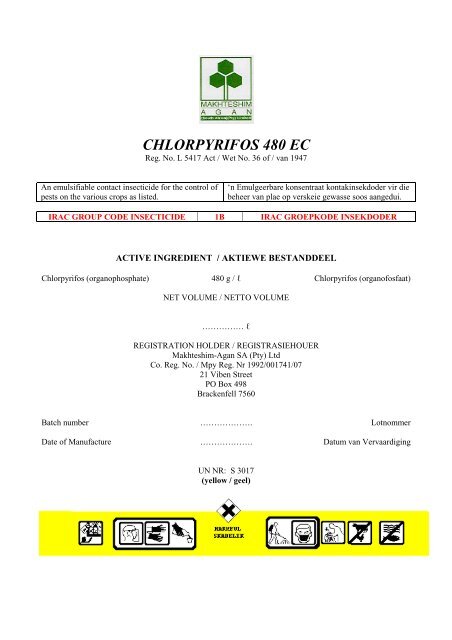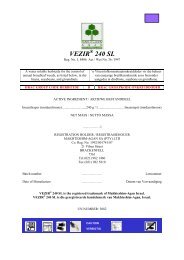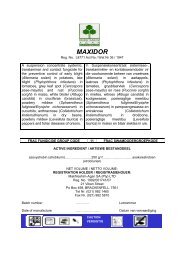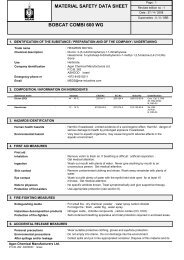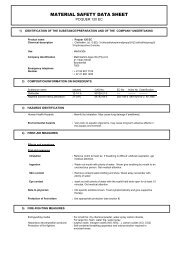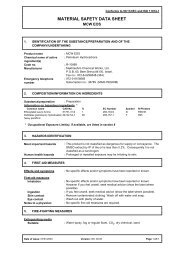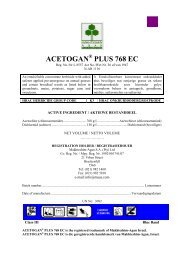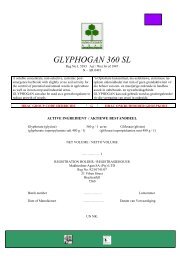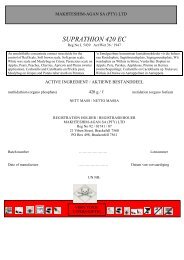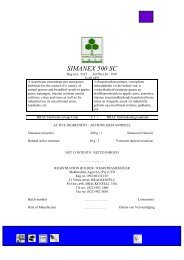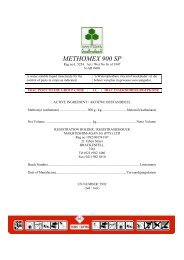CHLORPYRIFOS 480 EC - Makhteshim-Agan SA (Pty) Ltd
CHLORPYRIFOS 480 EC - Makhteshim-Agan SA (Pty) Ltd
CHLORPYRIFOS 480 EC - Makhteshim-Agan SA (Pty) Ltd
Create successful ePaper yourself
Turn your PDF publications into a flip-book with our unique Google optimized e-Paper software.
An emulsifiable contact insecticide for the control of<br />
pests on the various crops as listed.<br />
<strong>CHLORPYRIFOS</strong> <strong>480</strong> <strong>EC</strong><br />
Reg. No. L 5417 Act / Wet No. 36 of / van 1947<br />
‘n Emulgeerbare konsentraat kontakinsekdoder vir die<br />
beheer van plae op verskeie gewasse soos aangedui.<br />
IRAC GROUP CODE INS<strong>EC</strong>TICIDE 1B IRAC GROEPKODE INSEKDODER<br />
ACTIVE INGREDIENT / AKTIEWE BESTANDDEEL<br />
Chlorpyrifos (organophosphate) <strong>480</strong> g / ℓ Chlorpyrifos (organofosfaat)<br />
NET VOLUME / NETTO VOLUME<br />
…………… ℓ<br />
REGISTRATION HOLDER / REGISTRASIEHOUER<br />
<strong>Makhteshim</strong>-<strong>Agan</strong> <strong>SA</strong> (<strong>Pty</strong>) <strong>Ltd</strong><br />
Co. Reg. No. / Mpy Reg. Nr 1992/001741/07<br />
21 Viben Street<br />
PO Box 498<br />
Brackenfell 7560<br />
Batch number ………………. Lotnommer<br />
Date of Manufacture ………………. Datum van Vervaardiging<br />
UN NR: S 3017<br />
(yellow / geel)
WARNINGS:<br />
WITHOLDING PERIOD: Number of days which should be allowed between the last application<br />
and harvest or grazing (feeding) of the crop:<br />
Barley........................................................................................................................................... 43 days<br />
Citrus ........................................................................................................................................... 60 days<br />
Carrots, Lettuce ........................................................................................................................... 21 days<br />
Tobacco ....................................................................................................................................... 50 days<br />
Pastures ....................................................................................................................................... 14 days<br />
Grain sorghum, Dry beans, Wheat and Maize ............................................................................ 32 days<br />
Wheat and Maize (for grazing) ................................................................................................... 35 days<br />
Cabbage, Brussel sprouts, Potatoes, Cauliflower and Broccoli .................................................... 7 days<br />
Bananas, Grapes .......................................................................................................................... 28 days<br />
Tomatoes ....................................................................................................................................... 4 days<br />
• Handle with care.<br />
• Poisonous when absorbed through the skin, swallowed or inhaled.<br />
• Toxic to fish, bees and wildlife.<br />
• FLAMMABLE - Do not store near open flame.<br />
• Store in a cool place.<br />
• Store away from food and feedstuffs.<br />
• Keep under lock and key out of reach of children, uninformed persons and animals.<br />
• Aerial application: Notify all inhabitants in the immediate area to be sprayed and issue the<br />
necessary warnings. Do not spray over or allow drift to contaminate water or adjacent areas.<br />
Although this remedy has been extensively tested under a large variety of conditions, the<br />
registration holder does not guarantee that it will be effective under all conditions. The activity<br />
and effect thereof may be affected by factors such as abnormal soil, climatic and storage<br />
conditions, quality of dilution water, compatibility with other substances not indicated on the<br />
label and the occurrence of resistance of the weeds against the remedy as well as by the method,<br />
time and accuracy of application. The registration holder furthermore does not accept<br />
responsibility for damage to crops, vegetation, the environment or harm to man or animal or<br />
for lack of performance of the remedy concerned due to failure by the user to follow the label<br />
instructions, or to the occurrence of conditions which could not have been foreseen in terms of<br />
the registration. Consult the supplier in the event of any uncertainty.<br />
PR<strong>EC</strong>AUTIONS:<br />
• Do not inhale the spray mist.<br />
• Wash contaminated clothing after use.<br />
• Wash with soap and water after use or accidental skin contact.<br />
• Do not eat, drink or smoke whilst mixing or applying the product or before washing hands and<br />
face.<br />
• Avoid drift of spray onto other crops, grazing, rivers, dams and areas not under treatment.<br />
• Clean applicator before using it for other remedies. Dispose of wash water where it will not<br />
contaminate crops, grazing, rivers, dams etc.<br />
• Prevent contamination of food, feeds, drinking water and eating utensils.<br />
IMPORTANT: RINSING OF CONTAINER - TRIPLE RINSE.<br />
Invert the empty container over the spray or mixing tank and allow to drain for at least 30 seconds<br />
after the flow has slowed down to a drip. Thereafter rinse the container three times with a volume of<br />
water equal to a minimum of 10% of that of the container. Add the rinsings to the contents of the
spray tank before destroying the container in the prescribed manner. Destroy empty container by<br />
perforation and flattening and never use for any other purpose.<br />
SYMPTOMS OF HUMAN POISONING:<br />
Headache, fatigue, faintness, giddiness, excessive sweating, nausea, abdominal pains, vomiting,<br />
diarrhoea, tightness of the chest, anxiety, blurred vision, muscle twitchings beginning in the eyelids<br />
and tip of the tongue, mall pupils, respiratory distress, convulsions, coma.<br />
FIRST AID TREATMENT:<br />
Inhalation: Remove victim to fresh air and keep warm and at rest. If breathing is difficult give<br />
oxygen. If not breathing, apply artificial respiration. If necessary get medical<br />
attention.<br />
Ingestion: Induce vomiting, but only if victim is conscious. Never give anything by mouth to an<br />
unconscious person. Wash out mouth with water: If breathing is difficult give<br />
oxygen if breathing stops. Apply artificial respiration. Get immediate medical<br />
attention.<br />
Skin contact: Remove contaminated clothing. Wash off with plenty of cold water and soap.<br />
Eye contact: Wash off with plenty of running water for at least 15 minutes. Get medical attention.<br />
NOTE TO PHYSICIAN:<br />
Antidote 1: Atropine sulphate<br />
Antidote 2: Obidoxime chloride or Pralidoxime (PAM)<br />
Suggest serum and / or RBC cholinesterase determination. If ingested perform gastric lavage and<br />
administer activated charcoal.<br />
RESISTANCE WARNING:<br />
For resistance management <strong>CHLORPYRIFOS</strong> <strong>480</strong> <strong>EC</strong> is a group code E insecticide. Any insect<br />
population may contain individuals naturally resistant to <strong>CHLORPYRIFOS</strong> <strong>480</strong> <strong>EC</strong> and other group<br />
code E insecticides. The resistant individuals can eventually dominate the insect population if these<br />
insecticides are used repeatedly. These resistant insects may not be controlled by <strong>CHLORPYRIFOS</strong><br />
<strong>480</strong> <strong>EC</strong> and other group code E insecticides. To delay insect resistance the following can be done:<br />
• Avoid exclusive repeated use of insecticides from the same insecticide group code. Alternate or<br />
tank mix with products from different insecticide group codes.<br />
• Integrate the control methods (chemical, cultural, biological) into pest control programmes.<br />
For specific information on resistance management contact the registration holder of this product.<br />
DIR<strong>EC</strong>TION FOR USE: Use only as indicated.<br />
Ground application:<br />
<strong>CHLORPYRIFOS</strong> <strong>480</strong> <strong>EC</strong> can be applied by means of any suitable medium to high volume<br />
applicator provided it is equipped with an efficient agitator, it is able to distribute the spray evenly<br />
over the target area and it is calibrated correctly.<br />
Aerial application:<br />
Aerial application of <strong>CHLORPYRIFOS</strong> <strong>480</strong> <strong>EC</strong> may only be done by a registered Aerial<br />
Application Operator using a correctly calibrated, registered aircraft according to the instructions of<br />
<strong>SA</strong>NS Code 10118 (Aerial Application of Agricultural Pesticides). Ensure that the spray mixture is<br />
distributed evenly over the target area and that the loss of spray material during application is<br />
restricted to a minimum. It is therefore essential that the following criteria be met:
• Volume: A spray mixture volume of 30 litres per hectare is recommended. As this product has<br />
not been evaluated at a reduced volume rate, the registration holder cannot guarantee efficacy, or<br />
be held responsible for any adverse effects if this product is applied aerially at a lower volume<br />
rate than recommended above.<br />
• Droplet coverage: 30 to 40 droplets per cm² must be recovered at the target area.<br />
• Droplet size: A droplet spectrum with a VMD of 250 to 280 microns is recommended. Limit the<br />
production of fine droplets less than 150 microns (high drift and evaporation potential) to a<br />
minimum.<br />
• Flying height: Maintain the height of the spray boom at 3 to 4 metres above the target. Do not<br />
spray when aircraft dives, is in a climb or when banking<br />
• Use suitable atomising equipment that will produce the desired droplet size and coverage, but<br />
which will ensure the minimum loss of product. The spraying system must produce a droplet<br />
spectrum with the lowest possible Relative Span.<br />
• Position all the atomisers within the inner 60 to 75 % of the wingspan to prevent droplets from<br />
entering the wingtip vortices.<br />
• The difference in temperature between the wet and dry bulb thermometers, of a whirling<br />
hygrometer, should not exceed 8°C.<br />
• Stop spraying if the wind speed exceeds 15 km/h.<br />
• Stop spraying under turbulent, unstable and dry conditions during the heat of the day.<br />
• Spraying under temperature inversion conditions (spraying in or above the inversion layer) and/or<br />
high humidity conditions (relative humidity 80 % and above) may lead to the following:<br />
a) reduced efficacy due to suspension and evaporation of small droplets in the air<br />
(inadequate coverage).<br />
b) damage to other sensitive crops and/or non-target areas through drifting of the<br />
suspended spray cloud away from the target field.<br />
• Ensure that the Aerial Spray Operator knows exactly which fields to spray.<br />
• Obtain an assurance from the Aerial Spray Operator that the above requirements will be met and<br />
that relevant data will be compiled in a logbook and kept for future reference.
CROP and PEST DO<strong>SA</strong>GE / 100 ℓ<br />
WATER OR AS<br />
INDICATED<br />
APPLES, PEARS,<br />
PEACHES, PLUMS,<br />
APRICOTS<br />
Pernicious scale<br />
75mℓ<br />
(Quadraspidiotus<br />
perniciousus)<br />
Red scale<br />
(Aonidella aurantii)<br />
APPLES & PEARS<br />
75mℓ - 100mℓ<br />
Mealybugs<br />
(Pseudococcus calceolariae &<br />
(1,7 - 2,5ℓ / ha)<br />
Pseudococcus obscurus)<br />
APPLES<br />
Woolly aphid<br />
(Eriosoma lanigerum)<br />
BANANAS<br />
Flat mite<br />
(Brevipalpus californicus)<br />
Thrips<br />
(Hercinothrips bicinctus)<br />
75mℓ<br />
75mℓ<br />
REMARKS<br />
Apply only when the trees are dormant. At least two high volume sprays. Apply at 4 weeks intervals, one<br />
before and one after pruning.<br />
DORMANT APPLICATIONS ONLY:<br />
Apply two high volume sprays. First spray, with delayed foliation oil, at 3 weeks before bud swell / green tip.<br />
Second spray at bud swell / green tip. Use the higher dosage rate if a heavy fruit infestation was experienced in<br />
the previous season.<br />
PRE-HARVEST WOOLLY APHID CONTROL (Summer spray only):<br />
Apply as a full cover spray when the pest starts moving upwards into the trees or when first noticed. If<br />
colonization is observed after the initial application, apply a second spray not later than 40 days before harvest.<br />
The required spray volume for a specific growth stage should be accurately calculated according to the tree-rowvolume<br />
method of Unrath. The spray applied to control Woolly aphid will also control Codling moth for a<br />
period of 14 days. The <strong>CHLORPYRIFOS</strong> <strong>480</strong> <strong>EC</strong> spray should not replace the standard Woolly aphid spray.<br />
Spray Golden Delicious apples only if absolutely necessary as ring-marking of fruit may occur under certain<br />
growing conditions.<br />
<strong>CHLORPYRIFOS</strong> <strong>480</strong> <strong>EC</strong> spray will suppress Pernicious scale and Mealybugs.<br />
POST HARVEST WOOLLY APHID CONTROL:<br />
If necessary apply a <strong>CHLORPYRIFOS</strong> <strong>480</strong> <strong>EC</strong> as soon as possible after harvest.<br />
Apply as a high volume spray and ensure good coverage of each bunch. Commence spraying at the end July<br />
and repeat every 4 weeks until February.
CROP and PEST DO<strong>SA</strong>GE / 100 ℓ<br />
WATER OR AS<br />
BARLEY<br />
False Chinch bug<br />
(Nysius natalensis)<br />
Aphids<br />
(Schizaphis graninum,<br />
Rhopalosiphum padi,<br />
Diuraphis noxia)<br />
CITRUS<br />
Red scale<br />
(Aonidiella aurantii)<br />
Mussel scale<br />
(Cornuaspis beckii)<br />
Circular purple scale<br />
(Chrysomphalus aonidum)<br />
African bollworm<br />
(Helicoverpa armigera)<br />
Aphids<br />
(Toxoptera citricida &<br />
Aphis gossypii)<br />
Mealybugs<br />
(Planococcus citri,<br />
Nipaecoccus vastator,<br />
Paracoccus burnerae)<br />
Orange dog<br />
(Papilio spp)<br />
Psylla<br />
(Trioza erytreae)<br />
INDICATED<br />
750 - 1 000mℓ / ha<br />
100mℓ<br />
40mℓ + 1ℓ narrow<br />
distillation range<br />
spray oil<br />
REMARKS<br />
ONLY to be used under the recommendation of <strong>SA</strong>B Maltings<br />
Use higher dosage rate for the first application and where high infestation occurs. Start spraying when the first<br />
signs of infestation are observed. Repeat spray 8 - 10 days later if necessary. Apply in 200 - 300ℓ water / ha<br />
depending on size of the plants.<br />
Ground application: Apply as an overall spray<br />
Aerial application: Apply in not less than 30ℓ water/ha<br />
PREVENTIVE TREATMENT:<br />
Use in orchards where Red scale is under commercial control.<br />
1. Apply as a full cover spray at 80 - 100% petal fall.<br />
2. In hot low lying areas with young trees or in other areas where a second spray is considered necessary,<br />
re-apply 5 - 8 weeks after the spring spray.<br />
When a single preventive spray is required, apply 9 - 11 weeks after petal fall. In the case of double spray<br />
preventive programmes, precede this treatment with 100mℓ / 100ℓ water in the spring.<br />
WARNING: Do not apply if shade temperature exceeds 33C. Do not apply 35 days before or after Sulphur<br />
applications.<br />
IMPORTANT: In all cases apply treatments as a full cover spray. In all cases keep treated trees under<br />
observation and be prepared to apply a full corrective spray if scale infestation of fruit occurs in mid to late<br />
summer.<br />
75mℓ Apply as a full cover spray at blossoming or when pest is noticed. Repeat if necessary.<br />
20mℓ Apply as a light cover spray. Repeat if necessary.<br />
100ml or 60mℓ +<br />
500ml narrow<br />
distillation range<br />
spray oil<br />
Apply when first signs of pests are noticed. Repeat application if necessary. Apply as a full cover spray and<br />
ensure thorough coverage.<br />
40mℓ Apply as a light cover spray. Repeat if necessary.<br />
60mℓ<br />
Apply when eggs start to hatch on new growth. If possible apply on a spot spray basis. If swelling has already<br />
occurred on leaf surfaces, spraying will not correct abnormal growth.
CROP and PEST DO<strong>SA</strong>GE / 100 ℓ<br />
WATER OR AS<br />
CRUCIFERAE<br />
Aphids<br />
(Brevicoryne brassicae)<br />
Caterpillars of the Diamond<br />
back moth<br />
(Plutella xylostella)<br />
Greater cabbage moth<br />
(Crocidolomia binotalis)<br />
DRY BEANS, GRAIN<br />
SORGHUM<br />
Black maize beetle<br />
(Heteronychus arator)<br />
LAWNS<br />
Crickets<br />
(Gryllidae spp)<br />
Lawn caterpillars<br />
(Spodoptera spp)<br />
LETTUCE<br />
(Western Cape only)<br />
Cutworms<br />
(Agrotis spp)<br />
MAIZE<br />
Black maize beetle<br />
(Heteronychus arator)<br />
Stalkborer<br />
(Busseola fusca)<br />
50mℓ<br />
INDICATED<br />
10mℓ / 100m row<br />
length in 3ℓ water<br />
50mℓ<br />
40mℓ<br />
1 000mℓ / ha<br />
Row application:<br />
10mℓ / 100m row<br />
length in 3ℓ water<br />
Overall application:<br />
1ℓ / ha in 200ℓ water<br />
3,5mℓ / 100m row<br />
length in 3ℓ water<br />
REMARKS<br />
Apply when pest is first noticed. Dot not apply less than 500ℓ water / ha. Ensure thorough coverage of the<br />
whole plant. When aphids or the caterpillars are already in the cabbage head, or in the clusters of leaves of the<br />
Brussel sprouts, variable control can be expected. The addition of a wetting agent is recommended. If<br />
necessary, repeat application.<br />
Spray into the plant furrow just behind the planter shoe before closing the furrow.<br />
Apply 500mℓ of the mixture per m 2 as a drench when pest is noticed. Repeat application weekly until the<br />
population is under control and thereafter as necessary.<br />
Apply as an overall application when plants emerge. Repeat application every 7 - 14 days if necessary. Apply<br />
in at least 500ℓ water / ha.<br />
Apply in a 30cm band behind the planter press-wheel and cover with a layer of soil by dragging a piece of iron<br />
or a chain behind the planter. Apply as an overall spray prior to planting and mixing the soil to a depth of 10cm<br />
by using a suitable implement, e.g. a disc or Fieldspan.<br />
NB: These applications will suppress Cutworm. Less effective control can be expected under dry soil<br />
conditions. May be sprayed onto the soil surface without incorporation, if rain is expected within 24<br />
hours of application or before irrigation.<br />
GROUND APPLICATION ONLY:<br />
Early planting: Apply when 5% of the plants are infested with eggs or when 10% plants show "shot hole"<br />
damage. If control of this infestation is delayed too long, the larvae may be protected inside the stalk and poor<br />
results can be expected.<br />
Late planting: Apply the first spray 30 - 35 days after planting and repeat 14 days later.
CROP and PEST DO<strong>SA</strong>GE / 100 ℓ<br />
WATER OR AS<br />
PASTURES<br />
Army worm<br />
(Spodoptera exempta)<br />
POTATOES, CARROTS<br />
(Western Cape only)<br />
Cutworms<br />
(Agrotis spp)<br />
POTATOES<br />
Black maize beetle<br />
(Heteronychus arator)<br />
INDICATED<br />
250mℓ / ha Apply in 200 - 500ℓ water / ha.<br />
1 000mℓ / ha<br />
Pre-plant:<br />
15mℓ / 100m row<br />
length in 3ℓ water<br />
Post-plant:<br />
500mℓ / ha<br />
Cutworm<br />
(Agrotis spp) 1ℓ / ha<br />
TOBACCO<br />
Cutworm<br />
(Agrotis spp)<br />
Wireworm<br />
(Elateridae spp)<br />
TOMATOES<br />
African bollworm<br />
(Helicoverpa armigera)<br />
Looper<br />
(Ascotis selenaria)<br />
Thrips<br />
(Thrips tabaci)<br />
200mℓ / ha<br />
150 - 200mℓ<br />
150 - 200mℓ<br />
REMARKS<br />
Apply as an overall application when plants emerge. Repeat application at intervals of 2 - 3 weeks. Apply in at<br />
least 500ℓ water / ha.<br />
PROGRAMME APPLICATION:<br />
Apply in 10cm band just before closing the furrows.<br />
Apply 6 weeks later in not less than 500ℓ water / ha and increase the volume of water with the increase in crop<br />
density. Repeat at intervals of 2 - 3 weeks. Use drop arms and ensure good ground coverage. Rain or ridging is<br />
essential for good control.<br />
Apply just prior to tuber initiation in not less than 500ℓ water / ha and increase the volume of water with the<br />
increase in crop density. Repeat at 2 - 3 weeks intervals. Use drop arms and ensure good ground coverage.<br />
Rain or ridging is essential for good control.<br />
Apply 30mℓ per plant as a stem treatment and ensure thorough wetting of the stem and soil surrounding the base<br />
of the plant. Do not apply over the heart of the plant as this can cause leaf damage. Repeat if necessary.<br />
Apply as a full cover spray and repeat every 7 days. When a heavy African bollworm infestation occurs, the<br />
higher dose is recommended. Repeat this application every 7 days until the pest is under control. Thereafter<br />
continue spraying the lower dosage rate (150mℓ) every 7 days.<br />
Apply as a full cover spray and repeat every 7 days. The above spray programme for African bollworm and<br />
Looper will also control Thrips.
CROP and PEST DO<strong>SA</strong>GE / 100 ℓ<br />
WATER OR AS<br />
INDICATED<br />
WHEAT<br />
Russian wheat aphid<br />
(Diuraphis noxia) 750 - 1 000mℓ / ha<br />
Green and brown aphids<br />
(Schizaphis graminum<br />
Sitabion avenae<br />
Rhopalosiphum padi)<br />
WINE GRAPES<br />
Mealybugs<br />
(Planococcus ficus)<br />
Argentine ants (suppression)<br />
(Linepithema humile)<br />
WINE AND TABLE<br />
GRAPES<br />
(corrective sprays only)<br />
Cocktail ants<br />
(Crematogaster sp)<br />
TABLE GRAPES<br />
Mealybugs<br />
(Planococcus ficus)<br />
750mℓ / ha<br />
75mℓ<br />
100mℓ<br />
200mℓ<br />
400mℓ<br />
200mℓ (two<br />
applications)<br />
REMARKS<br />
Use higher dosage rate for the first application and where high infestation occurs. Start spraying when the first<br />
signs of infestation are observed. Repeat spray 8 - 10 days later if necessary. Apply in 200 - 300ℓ water / ha<br />
depending on size of the plants.<br />
Ground application: Apply as an overall spray<br />
NOTE: This application will also suppress Black maize beetle.<br />
Spray if the aphid population is on the increase, and very few ladybird predators and parasites are present.<br />
Ground or aerial application.<br />
SUMMER SPRAY ONLY:<br />
Apply when the first movement of Mealybugs are noticed. Apply as a high volume application ensuring<br />
thorough coverage of the vines. Repeat after 21 days if necessary. Do not apply during bud swell or within 4<br />
weeks from budding.<br />
DORMANT SPRAYS ONLY:<br />
For low infestation pressure.<br />
For high infestation pressure.<br />
Apply two applications at 2 week intervals before budburst. Apply as high volume applications to ensure<br />
optimum coverage.<br />
NOTE: Argentine ants, if present at the time of application, will be suppressed by all three dosage regimes.<br />
Cocktail ants will be controlled by the highest dosage but only suppressed by the middle dosage.<br />
Refer to the paragraph above.<br />
DORMANT SPRAY ONLY:<br />
Apply as a single spray when Cocktail ants are present. Apply as a high volume application to ensure optimal<br />
coverage.<br />
NOTE: This application will also control Mealybugs and suppress Argentine ants if present at application.<br />
DORMANT SPRAY ONLY:<br />
Apply 2 sprays in the later winter dormant period. The first spray should commence approximately 6 weeks<br />
before budburst. The second spray should be applied a minimum of 7 days after the first spray, but before any<br />
signs of green growth are evident. (<strong>CHLORPYRIFOS</strong> <strong>480</strong> <strong>EC</strong> is phytotoxic to young vine leaves). Use only<br />
hand gun type high volume sprays. Vines should be individually drenched down to ground level with minimum<br />
of 4ℓ spray mixture / vine.<br />
Follow-up sprays: In. certain vineyards high population pressure and poor application might necessitate<br />
follow-up sprays in summer. As soon as Mealybugs are observed, apply another suitable registered chemical.
CROP and PEST DO<strong>SA</strong>GE / 100 ℓ<br />
WATER OR AS<br />
ORNAMENTALS<br />
African bollworm<br />
(Helicoverpa armigera)<br />
Aphids<br />
(Aphididae spp)<br />
Mealybugs<br />
(Pseudococcidae spp)<br />
Australian bug<br />
(Icerya purchasi)<br />
Pernicious scale<br />
(Quadraspidiotus<br />
perniciousus)<br />
Red scale<br />
(Aonidiella aurantii)<br />
Red spider mite<br />
(Tetranychus uriticae<br />
Tetranychus kanzawai)<br />
ANTS<br />
(Formicidae spp)<br />
BEDBUGS<br />
OUTDOOR, SEWAGE<br />
FARMS, ABATTOIRS,<br />
PIGSTIES, BARNS AND<br />
STABLES<br />
Flies<br />
Mosquitoes<br />
INDICATED<br />
REMARKS<br />
50mℓ Apply as a full cover spray as soon as pest is noticed and repeat when necessary.<br />
100mℓ Apply as a full cover spray when pest is noticed and repeat when necessary.<br />
75mℓ Apply 2 sprays 4 weeks apart, thoroughly wetting the wood while plants are dormant.<br />
100mℓ Apply as a full cover spray ensuring under leaf coverage. Repeat as necessary every 14 days.<br />
20mℓ / 10ℓ water<br />
50mℓ / 10ℓ water<br />
German and American<br />
cockroach 100mℓ / 10ℓ water<br />
GARDENS:<br />
Apply around nests and trials. Repeat if necessary.<br />
BUILDINGS:<br />
Apply as a coarse droplet spray or by means of a paint brush onto walls inside cupboards and places where ants<br />
occur.<br />
Apply as a course droplet spray or by means of a paint brush onto walls, woodwork, bedsteads and other<br />
possible hiding places, but only lightly to mattresses.<br />
100mℓ / 10ℓ water Apply as a course droplet spray or by means of a paint brush to poles, windowsills, walls and roofs.<br />
Apply as a coarse droplet spray or by means of a paint brush onto skirting boards, underneath wash basins, water<br />
piping, behind refrigerator units, stoves and geysers, inside cupboards and all other places frequented by<br />
cockroaches.
WAARSKUWINGS:<br />
ONTHOUDINGSPERIODES: Minimum tyd wat moet verstryk tussen laaste toediening en oes of<br />
voer/beweiding.<br />
Gars.................................................................................................................................................43 dae<br />
Geelwortels, Blaarslaai ...................................................................................................................21 dae<br />
Kopkool, Brusselspruite, Aartappels, Blomkool en Broccoli...........................................................7 dae<br />
Koring en Mielies ...........................................................................................................................32 dae<br />
Koring en Mielies (vir beweiding)..................................................................................................35 dae<br />
Piesangs, Druiwe.............................................................................................................................28 dae<br />
Sitrus ...............................................................................................................................................60 dae<br />
Tabak ..............................................................................................................................................50 dae<br />
Tamaties............................................................................................................................................4 dae<br />
Weiding...........................................................................................................................................14 dae<br />
• Hanteer versigtig.<br />
• Giftig indien deur die vel geabsorbeer, ingesluk of ingeasem word.<br />
• Giftig vir visse, bye en wild.<br />
• VLAMBAAR - Moenie naby oop vlamme berg nie.<br />
• Berg in 'n koel plek.<br />
• Berg weg van kos en voer.<br />
• Hou buite bereik van kinders, oningeligte persone en diere.<br />
• Lugtoediening: Stel al die inwoners in die onmiddellike omgewing van die gebied wat bespuit<br />
gaan word in kennis en reik die nodige waarskuwings uit. Moet nie oor aangrensende gebiede of<br />
water spuit of die spuitnewel toelaat om dit te besoedel nie.<br />
Alhoewel hierdie middel omvattend onder ‘n groot verskeidenheid toestande getoets is,<br />
waarborg die registrasiehouer nie dat dit onder alle toestande doeltreffend sal wees nie.<br />
Die werking en doeltreffendheid daarvan kan beïnvloed word deur faktore soos<br />
abnormale grond, klimaats- en bergingstoestande, kwaliteit van die verdunningswater,<br />
verenigbaarheid met ander stowwe wat nie op die etiket aangedui word nie en die<br />
voorkoms van weerstand van die onkruide teen die betrokke middel sowel as die tyd en<br />
akkuraatheid van toediening. Verder aanvaar die registrasiehouer nie<br />
verantwoordelikheid vir skade aan gewasse, plantegroei en die omgewing of nadelige<br />
invloede op mens of dier of vir ‘n gebrek aan prestasie van die betrokke middel as<br />
gevolg van versuim van die gebruiker om etiketaanwysings na te kom, of as gevolg van<br />
die onstaan van toestande wat nie kragtens die registrasie voorsien kon word nie.<br />
Raadpleeg die verskaffer in die geval van enige onsekerheid.<br />
VOORSORGMAATREëLS:<br />
• Vermy inaseming van sproeinewel.<br />
• Was gekontamineerde klere na gebruik.<br />
• Was met seep en water na gebruik of per abuis velkontak.<br />
• Moet nie eet, drink of rook terwyl gemeng of toegedien word of voordat hande en gesig gewas is<br />
nie.<br />
• Vermy wegdrywing van sproeinewel na ander gewasse, weidings, riviere en damme.<br />
• Maak toerusting skoon voordat dit vir ander middels gebruik word en gooi sproeiwater weg waar<br />
dit nie gewasse, weidings, riviere en damme sal besoedel nie.<br />
• Voorkom besoedeling van voedsel, voer, drinkwater en eetgerei
BELANGRIK: UITSPOEL VAN HOUER - DRIEDUBBELE UITSPOELING:<br />
Keer die leë houer om oor die spuittenk of mengbak en dreineer vir minstens 30 sekondes nadat die<br />
vloei tot 'n gedrup verminder het. Spoel die houer daarna drie keer uit met 'n volume water<br />
gelykstaande aan 'n minimum van 10% van die houer. Gooi die spoelwater by die inhoud van die<br />
spuittenk voordat die houer op die voorgeskrewe wyse vernietig word. Vernietig leë houer deur gate<br />
daarin te maak en plat te druk Moet vir geen ander doel gebruik word nie.<br />
SIMPTOME VAN MENSLIKE VERGIFTIGING:<br />
Hoofpyn, moegheid, duiseligheid, oormatige sweet, naarheid, maagpyn, braking, diarree, benoudheid<br />
op bors, angstigheid, versteurde visie, spiersametrekking beginnende in die ooglede en punt van tong,<br />
vernoude pupille, asemhalingsnood, konvulsies, koma.<br />
NOODHULP:<br />
Inaseming: Neem die pasiënt na vars lug en hou hom warm en gerus. As moeilik asem gehaal<br />
word, gee suurstof. As asemhaling ophou pas kunsmatige asemhaling toe. Kry<br />
mediese aandag.<br />
Inname: Veroorsaak braking maar alleenlik as pasiënt by sy bewussyn is. Moet nooit enige<br />
iets per mond in bewustelose persoon gee nie. Was mond uit met water. Indien<br />
asemhaling moeilik is, gee suurstof. As asemhaling staak, pas kunsmatige<br />
asemhaling. Kry onmiddellike mediese hulp.<br />
Velkontak: Verwyder besoedelde klere. Was met baie koue water en seep. Kry mediese<br />
behandeling.<br />
Oogkontak: Was oog uit met baie lopende water vir 15 minute. Kry mediese hulp.<br />
NOTA AAN GENEESHEER:<br />
Teenmiddel 1: Atropiensulfaat<br />
Teenmiddel 2: Obidoksien chloride of Praldoksien (PAM)<br />
Stel voor om serum en / of RBC cholinesterase te bepaal. Indien ingeneem is gee ‘n maagspoeling en<br />
geaktiveerde koolstof.<br />
WEERSTANDSWAARSKUWING:<br />
Vir weerstandsbestuur word <strong>CHLORPYRIFOS</strong> <strong>480</strong> <strong>EC</strong> as ‘n groepkode E insekdoder<br />
geklassifiseer. Enige insekpopulasie mag individue bevat wat natuurlik weerstandbiedend teen<br />
<strong>CHLORPYRIFOS</strong> en ander groepkode E insekdoders is. Hierdie weerstandbiedende individue kan<br />
uiteindelik die insekpopulasie oorheers as hierdie insekdoders aanhoudend gebruik word. Hierdie<br />
weerstandbiedende insekte mag dalk nie deur <strong>CHLORPYRIFOS</strong> <strong>480</strong> <strong>EC</strong> en ander groepkode E<br />
insekdoders beheer word nie. Om insekweerstand te vertraag kan die volgende gedoen word.<br />
• Vermy die eksklusiewe aanhoudende gebruik van insekdoders uit dieselfde groepkode.<br />
Wissel af of maak tenkmengsels met insekdoders van ander groepkodes<br />
• Integreer beheermetodes (chemise, bewerking, biologies) in beheerprogramme<br />
Vir meer spesifieke inligting rakende weerstandbestuur, skakel met die registrasiehouer van hierdie<br />
produk.<br />
GEBRUIK<strong>SA</strong>ANWYSINGS: Gebruik slegs soos aangedui.<br />
Grondtoediening:<br />
<strong>CHLORPYRIFOS</strong> <strong>480</strong> <strong>EC</strong> kan met enige medium tot hoëvolume spuitapparaat toegedien word,<br />
mits dit toegerus is met ‘n doeltreffende roermeganisme en dit in staat is om die spuitmengsel
eweredig oor die teikengebied te versprei. Dit is belangrik om daarop te let dat die spuitapparaat wat<br />
gberuik word, korrek gekalibreer is.<br />
Lugtoediening:<br />
<strong>CHLORPYRIFOS</strong> <strong>480</strong> <strong>EC</strong> kan slegs deur ‘n geregistreerde Lugbespuitingsperateur met ‘n korrek<br />
gekalibreerde, geregistreerde vliegtuig volgens die instruksies van <strong>SA</strong>BS Kode 10118 (Aerial<br />
Application of Agricultural Pesticides) uit die lug bespuit word. Verseker dat die spuitmengsel<br />
eweredig oor die teikenarea versprei word, en die verlies aan spuitmengsel tydens toediening tot ‘n<br />
minimum beperk word. Dit is daarom belangrik om aan die volgende vereistes te voldoen:<br />
• Volume: ‘n Spuitmengsel volume van 30 liter per ha word aanbeveel. Hierdie produk is nie teen<br />
‘n verlaagde volume getoets nie. Die registrasiehouer kan nie effektiteit waarborg, of<br />
verantwoordelik gehou word vir enige nadelige effekte indien hierdie produk teen ‘n laer volume,<br />
as hierbo aanbeveel, toegedien word nie.<br />
• Druppel bedekking: 30 tot 40 druppels per cm² moet op die teikenarea herwin word.<br />
• Druppelgrootte: ‘n Druppelspektrum met ‘n VMD van 250 tot 280 mikrons word aanbeveel.<br />
Beperk die produksie van druppels kleiner as 150 mikrons (hoë drywing en<br />
verdampingspotensiaal) tot ‘n minimum.<br />
• Vlieghoogte: Handhaaf die hoogte van die spuitbalk bo die teiken op 3 tot 4 meter. Moet nie spuit<br />
wanneer die vliegtuig duik nie, uitklim of draai nie.<br />
• Gebruik geskikte atomiseringsapparaat wat die vereiste druppelgrootte en bedekking sal produseer,<br />
maar die minste verlies van produk verseker. Die spuitstelsel moet ‘n druppelspektrum met die<br />
kleinste moontlike Relatiewe Span produseer.<br />
• Plaas al die atomiseerders in die binnste 60 tot 75 % van die vlerkspan om te verhoed dat druppels<br />
binne-in die vlerkpuntvorteks beweeg.<br />
• Die verskil in temperatuur tussen die nat- en droëboltermometer van ‘n swaaihigrometer, moet nie<br />
8°C oorskry nie.<br />
• Stop bespuiting indien die windspoed 15 km/h oorskry.<br />
• Stop bespuiting tydens turbulente, onstabiele en droë toestande gedurende die hitte van die dag.<br />
• Bespuiting onder temperatuur inversie toestande (deur bo of binne die inversie laag te spuit) en/of<br />
hoë lugvog toestande (relatiewe humiditeit 80% en meer) mag tot volgende probleme aanleiding<br />
gee:<br />
a) verlaagde effektiwiteit aangesien die druppels as ‘n wolk in die lug bly hang en moontlik<br />
verdamp (onvoldoende bedekking op teiken).<br />
b) skade aan nie-teiken gewasse of sensitiewe areas as gevolg van wegdrywing van die<br />
spuitwolk na nie-teiken area.<br />
• Verseker dat die Lugbespuitingsoperateur presies weet watter lande bespuit moet word.<br />
• Dit is noodsaaklik om ‘n versekering van die Lugbespuitingsoperateur te verkry dat aan al die<br />
bogenoemde vereistes voldoen sal word en dat data van belang in ‘n logboek saamgevat is vir<br />
toekomstige verwysing.
GEWAS en PLAAG DOSIS / 100 ℓ<br />
WATER OF SOOS<br />
AARTAPPELS,<br />
GEELWORTELS<br />
(Westelike Provinsie alleen)<br />
Snywurm<br />
(Agrotis spp)<br />
AARTAPPELS<br />
Swartmieliekewer<br />
(Heteronychus arator)<br />
Snywurm<br />
(Agrotis spp)<br />
APPELS, PERE,<br />
PERSKES, PRUIME,<br />
APPELKOSE<br />
Verderflike dopluis<br />
(Quadraspidiotus<br />
perniciousus)<br />
Rooidopluis<br />
(Aonidella aurantii)<br />
APPELS en PERE<br />
Witluise<br />
(Pseudococcus calceolariae &<br />
Pseudococcus obscurus)<br />
AANGEDUI<br />
1 000mℓ / ha<br />
Voorplant:<br />
15mℓ / 100m<br />
rylengte in 3ℓ water<br />
Na-plant:<br />
500mℓ / ha<br />
1ℓ / ha<br />
75 mℓ<br />
75mℓ - 100mℓ<br />
(1,7 - 2,5ℓ / ha)<br />
OPMERKINGS<br />
Dien toe as 'n algehele bespuiting wanneer die plante opkom. Herhaal toediening met tussenposes van 2 - 3<br />
weke. Dien toe in ten minste 500ℓ water / ha.<br />
PROGRAM TOEDIENING:<br />
Dien in 10 cm strook net voordat plantvoor toegemaak word, toe.<br />
Dien toe 6 weke later in nie minder as 500ℓ water / ha en vermeerder die volume water met die toename van<br />
gewasdigtheid. Herhaal met 2 tot 3 weke tussenposes. Gebruik valarms en verseker sodoende 'n goeie<br />
grondbedekking. Reën of operd na toediening is noodsaaklik vir goeie beheer.<br />
Dien toe net voor knolvorming begin in nie minder as 500ℓ water / ha en vermeerder die volume water met die<br />
toename van gewasdightheid. Herhaal met 2 - 3 weke tussenposes. Gebruik valarms en verseker sodoende 'n<br />
goeie grondbedekking. Reën of operd na toediening is noodsaaklik vir goeie beheer.<br />
Dien slegs gedurende rusperiode van bome toe. Ten minste twee hoëvolume bespuitings met tussenposes van 4<br />
weke, een voor en een na snoei, moet toegedien word.<br />
SLEGS RUSTYDPERKTOEDIENINGS:<br />
Dien twee hoëvolume bespuitings toe. Dien die eerste bespuiting met die vertraagde-bot-olie-bespuiting toe 3<br />
weke voor ogieswel / groenpunt. Die tweede bespuiting met ogieswel / groenpunt. Gebruik die hoër<br />
toedieningshoeveelheid waar swaar vrugbesmetting die vorige seisoen ondervind is.
GEWAS en PLAAG DOSIS / 100 ℓ<br />
WATER OF SOOS<br />
APPELS<br />
Appelbloedluis<br />
(Eriosoma lanigerum)<br />
BLAARSLAAI<br />
(Westelike Provinsie alleen)<br />
Snywurm<br />
(Agrotis spp)<br />
DROëBONE,<br />
GRAANSORGHUM<br />
Swartmieliekewer<br />
(Heteronychus arator)<br />
GARS<br />
Stinkluis<br />
(Nysius natalensis)<br />
Plantluise<br />
(Schizaphis graninum,<br />
Rhopalosiphum padi,<br />
Diuraphis noxia)<br />
75mℓ<br />
AANGEDUI<br />
1 000mℓ / ha<br />
10mℓ / 100m<br />
rylengte in 3ℓ water<br />
750 - 1 000mℓ / ha<br />
OPMERKINGS<br />
VOOR-OES BEHEER VAN BLOEDLUIS (Slegs somerbespuitings):<br />
Dien as 'n volle dekbespuiting toe wanneer plaag opwaarts in die bome begin inbeweeg of sodra dit waargeneem<br />
word. Indien kolonisering na die aanvanklike bespuiting waargeneem word, dien 'n opvolgbespuiting toe nie<br />
later as 40 dae voor oes nie. Spuitvolumes benodig per ha vir 'n spesifieke groeistadium moet akkuraat volgens<br />
die boom-ry-volume metode van Unrath bepaal word. Bespuiting toegedien vir die beheer van Bloedluis sal ook<br />
Kodlingmot vir 14 dae beheer. Die <strong>CHLORPYRIFOS</strong> <strong>480</strong> <strong>EC</strong> bespuiting moet nie die standaard<br />
Bloedluisbespuiting vervang nie.<br />
Spuit Golden Delicious appels slegs wanneer absoluut nodig want ringmerke mag moontlik op vrugte onder<br />
seker groeitoestande voorkom.<br />
Verderflike Dopluis en Witluis sal deur hierdie <strong>CHLORPYRIFOS</strong> <strong>480</strong> <strong>EC</strong> bespuiting onderdruk word.<br />
NA-OES BEHEER VAN BLOEDLUIS:<br />
Indien nodig dien 'n <strong>CHLORPYRIFOS</strong> <strong>480</strong> <strong>EC</strong> bespuiting so gou as moontlik na oes toe.<br />
Dien toe as 'n algehele bespuiting wanneer die plante opkom. Herhaal toediening elke 7 tot 14 dae indien nodig.<br />
Dien toe in ten minste 500ℓ water/ha.<br />
Spuit in die plantvoor direk agter die planterskoen voordat die voor toegemaak word.<br />
SLEGS vir gebruik onder aanbeveling van <strong>SA</strong>B Maltings<br />
Gebruik die hoër dosis vir die eerste bespuiting en waar besonder swaar besmetting voorkom. Begin toediening<br />
as eerste tekens van besmetting waargeneem word. Herhaal bespuiting 8 - 10 dae later indien nodig.<br />
Afhangende van plantgrootte, dien 200 - 300ℓ water / ha toe.<br />
Grondtoediening: Dien toe as 'n algehele bespuiting.<br />
Lugbespuiting: Dien toe in nie minder as 30ℓ water/ha
GEWAS en PLAAG DOSIS / 100 ℓ<br />
WATER OF SOOS<br />
AANGEDUI<br />
GRASPERKE<br />
Krieke<br />
50mℓ<br />
(Gryllidae spp)<br />
Grasperkruspes<br />
40mℓ<br />
(Spodoptera spp)<br />
KOOLGEWASSE<br />
Plantluise<br />
(Brevicornyne brassicae)<br />
Ruspes van die Ruitrugmot 50mℓ<br />
(Plutella xylostella)<br />
Groter Koolmot<br />
(Crocidolomia binotalis)<br />
KORING<br />
Russiese koringluis<br />
(Diuraphis noxia) 750 - 1 000mℓ / ha<br />
Groen en bruin plantluise<br />
(Schizaphis graminum<br />
Sitabion avenae<br />
Rhopalosiphum padi)<br />
MIELIES<br />
Swartmieliekewer<br />
(Heteronychus arator)<br />
Stronkboorder<br />
(Busseola fusca)<br />
750mℓ / ha<br />
Rytoediening:<br />
10mℓ / 100m<br />
rylengte in 3ℓ water<br />
Algehele toediening:<br />
1ℓ / ha in 200ℓ water<br />
3,5mℓ / 100m<br />
rylengte in 3ℓ water<br />
OPMERKINGS<br />
Dien 500mℓ van die mengsel per m 2 toe wanneer plaag opgemerk word en herhaal toediening weekliks totdat<br />
die populasie onder beheer is - daarna herhaal toediening soos nodig.<br />
Dien toe wanneer die plae vir die eerste keer opgemerk word. Moet nie minder as 500ℓ water / ha toedien nie.<br />
Sorg vir die deeglike benatting van die hele plant. Wanneer die plantluise of ruspes alreeds binne in die koolkop<br />
of tussen die blare van die Brusselspruite is, kan wisselvallige beheer verwag word. Die byvoeging van 'n<br />
benattingsmiddel word aanbeveel. Herhaal toediening wanneer nodig.<br />
Gebruik die hoër dosis vir die eerste bespuiting en waar besonder swaar besmetting voorkom. Begin toediening<br />
as eerste tekens van besmetting waargeneem word. Herhaal bespuiting 8 - 10 dae later indien nodig.<br />
Afhangende van plantgrootte, dien 200 - 300ℓ water / ha toe.<br />
Grondtoediening: Dien toe as 'n algehele bespuiting.<br />
NOTA: Hierdie toediening sal ook Swartmieliekewer onderdruk.<br />
Spuit wanneer die luisbevolking toeneem en daar weinig skilpadbesiepredatore of parasiete teenwoordig is.<br />
Grond- of lugtoediening.<br />
Dien toe as 'n 30cm baan agter die planterdrukwiel en bedek grond deur van 'n sleepyster of ketting gebruik te<br />
maak. Dien toe as 'n algehele bespuiting voor planttyd en vermeng tot 'n diepte van 10cm met die grond deur<br />
gebruik te maak van 'n geskikte implement, bv. skotteleg of Fieldspan.<br />
NB: Hierdie toedienings sal Snywurm onderdruk. Minder effektiewe beheer kan verwag word onder<br />
droë grondtoestande. Mag ook sonder inwerking op die grondoppervlak gespuit word indien reën binne<br />
24 uur na toediening verwag word of voor besproeiing.<br />
SLEGS GRONDTOEDIENING:<br />
Vroeë plantdatum: Dien toe sodra 5% van die plante met eiers besmet is of wanneer 10% van die plante<br />
"haelskade" simptone toon. Indien daar te lank gewag word sal die ruspes te diep indring en buite bereik van die<br />
insekdoder wees wat swak resultate tot gevolg sal hê.<br />
Laat plantdatum: Dien eerste bespuiting toe 30 - 35 dae na plant en herhaal 14 dae later.
GEWAS en PLAAG DOSIS / 100 ℓ<br />
WATER OF SOOS<br />
PIE<strong>SA</strong>NGS<br />
Blaaspootjies<br />
(Hercinothrips bicinctus)<br />
Plantmyt<br />
(Brevipalpus californicus)<br />
SITRUS<br />
Rooidopluis<br />
(Aonidiella aurantii)<br />
Mosseldopluis<br />
(Cornuaspis beckii)<br />
Rondepersdopluis<br />
(Chrysomphalus aonidum)<br />
Afrika bolwurm<br />
(Helicoverpa armigera)<br />
Plantluise<br />
(Toxoptera citricida<br />
Aphis gossypii)<br />
Witluise<br />
(Planococcus citri<br />
Nipaecoccus vastator<br />
Paracoccus burnerae)<br />
Lemoenvlinderruspe<br />
(Papilio spp)<br />
Lemoenbladvlooi (Silla)<br />
(Trioza erytreae)<br />
75mℓ<br />
100mℓ<br />
AANGEDUI<br />
40mℓ + 1ℓ<br />
smalbestekdistilasie<br />
spuitolie<br />
OPMERKINGS<br />
Dien toe as 'n hoë volume bespuiting en sorg vir goeie bedekking. Dien die eerste bespuiting aan die eiende van<br />
Julie toe en herhaal tot Februarie met tussenposes van 4 weke.<br />
VOORKOMENDE BEHANDELING: Gebruik in boorde waar Rooidopluis kommersieël onder beheer is.<br />
1. Dien as 'n volle dekbespuiting toe teen 80 - 100% blomblaarval.<br />
2. In warm laagliggende gebiede met spesiale verwysing na jong bome of in ander areas waar 'n tweede<br />
bespuiting nodig geag word, herhaal toediening 5 - 8 weke na die lentetoediening.<br />
Waar 'n enkele voorkomende bespuiting verlang word, dien toe 9 - 11 weke na blomblaarval. In die geval van 'n<br />
dubbel voorkomende bespuitingsprogram, moet behandeling voorafgegaan word met 100mℓ / 100ℓ water in die<br />
lente.<br />
WAARSKUWING: Moet nie toedien as die skadutemperatuur oor 33°C gaan nie. Moet nie binne 35 dae voor<br />
of na 'n swaelaanwending toedien nie.<br />
BELANGRIK: Dien in alle gevalle as 'n volle dekbespuiting toe. In alle gevalle hou behandelde bome onder<br />
observasie en wees voorbereid om 'n korrektiewe behandeling toe te dien, indien Rooidopluis infestasie op die<br />
vrugte gedurende middel tot laat somer voorkom.<br />
75mℓ Dien toe met blomtyd as 'n volle dekbespuiting wanneer plaag opgemerk word. Herhaal indien nodig.<br />
20mℓ Dien toe as 'n ligte dekbespuiting. Herhaal indien nodig.<br />
100ml of 60mℓ +<br />
500ml<br />
smalbestekdistillasie<br />
spuitolie<br />
Dien toe wanneer plaag opgemerk word. Herhaal toediening indien nodig. Dien toe as 'n volle dekbespuiting en<br />
verseker deeglike bedekking.<br />
40mℓ Dien toe as 'n ligte dekbespuiting. Herhaal indien nodig.<br />
60mℓ<br />
Dien toe wanneer die eiers uitbroei op die nuwe groeivlaag. Indien moontlik, wend lokaal (kol-kol) aan. Indien<br />
die uitstulpings alreeds op blare begin vorm, sal bespuiting nie meer abnormale groei kan verhoed nie.
GEWAS en PLAAG DOSIS / 100 ℓ<br />
WATER OF SOOS<br />
TABAK<br />
Snywurm<br />
(Agrotis spp)<br />
Draadwurm<br />
(Elateridae spp)<br />
TAMATIES<br />
Afrika bolwurm<br />
(Helicoverpa armigera)<br />
Plusia landmeter<br />
(Ascotis selenaria)<br />
Blaaspooitjie<br />
(Thrips tabaci)<br />
WEIDINGS<br />
Kommandowurm<br />
(Spodoptera exempta)<br />
WYNDRUIWE<br />
Witluis<br />
(Planococcus ficus)<br />
Argentynse mier<br />
(onderdrukking)<br />
(Linepithema humile)<br />
WYN- EN TAFELDRUIWE<br />
(slegs korrektiewe<br />
bespuiting)<br />
Wipstertmiere<br />
(Crematogaster spp)<br />
AANGEDUI<br />
200mℓ / ha<br />
150 - 200mℓ<br />
150 - 200mℓ<br />
OPMERKINGS<br />
Dien 30mℓ per plant toe as stambehandeling en verseker deeglike benatting van die stam en grond aan die basis<br />
van die plant. Moet nie oor die kroon van die plant toedien nie, aangesien blaarbrand mag voorkom. Herhaal<br />
indien nodig.<br />
Dien toe as 'n volle dekbespuiting en herhaal elke 7 dae. Wanneer 'n hoë infestasie voorkom word die hoër<br />
dosis aanbeveel. Herhaal toediening elke 7 dae totdat plaag onder beheer is. Gaan daarna voort met die<br />
bespuiting teen die laer toedieningshoeveelheid (150mℓ) elke 7 dae.<br />
Dien toe as 'n volle dekbespuiting en herhaal elke 7 dae. Die bogenoemde spuitprogram vir Afrika bolwurm en<br />
Plusia landmeter sal ook Blaaspootjies beheer.<br />
250mℓ / ha Dien toe in 200 - 500ℓ water / ha.<br />
75mℓ<br />
100mℓ<br />
200mℓ<br />
400mℓ<br />
SLEGS SOMERBESPUITING:<br />
Dien toe as 'n hoëvolume bespuiting ten einde optimum bedekking te verseker. Dien toe sodra Witluisbeweging<br />
waargeneem word. Herhaal na 21 dae indien nodig. Moet nie tydens ogieswel en binne 4 weke na bot toedien<br />
nie.<br />
SLEGS WINTERBESPUITING:<br />
Vir lae infestasiedruk<br />
Vir hoë infestasiedruk<br />
Dien toediening met 'n 2-weekse tussenposes toe voor bot. Dien as 'n hoëvolume bespuiting toe om die<br />
besmoontlike bedekking te verseker.<br />
NOTA: Argentynse miere, indien teenwoordig tydens spuit, sal deur al drie bogenoemde dosissterktes<br />
onderdruk word. Wipstertmiere sal deur die hoogste dosis beheer word en deur die middelste dosis onderdruk<br />
word.<br />
Verwys ook na die paragraaf hierbo.<br />
SLEGS WINTERBESPUITING:<br />
Dien toe as 'n enkele bespuiting wanneer Wipstertmiere teenwoordig is. Dien toe as 'n hoëvolume bespuiting<br />
ten einde optimum bedekking te verseker.<br />
LET WEL: Hierdie toediening sal ook Witluis beheer en Argentynse miere onderdruk indien teenwoordig<br />
tydens bespuiting.
GEWAS en PLAAG DOSIS / 100 ℓ<br />
WATER OF SOOS<br />
TAFELDRUIWE<br />
Witluis<br />
(Planococcus ficus)<br />
SIERPLANTE<br />
Afrika bolwurm<br />
(Helicoverpa armigera)<br />
Plantluise<br />
(Aphididae spp)<br />
Witluis<br />
(Pseudococcidae spp)<br />
Australiese luis<br />
(Icerya purchasi)<br />
Verderflike dopluis<br />
(Quadraspidiotus<br />
perniciousus)<br />
Rooidopluis<br />
(Aonidiella aurantii)<br />
Rooispinmyt<br />
(Tetranychus uriticae<br />
Tetranychus kanzawai)<br />
MIERE<br />
(Formicidae spp)<br />
WEELUISE<br />
AANGEDUI<br />
200mℓ<br />
(twee bespuitings)<br />
OPMERKINGS<br />
SLEGS WINTERBESPUITING:<br />
Dien 2 bespuitings toe tydens die latere deel van die rustyd. Die eerste behoort omtrent 6 weke voor bot plaas te<br />
vind, en die tweede ten minste 7 dae later, maar voordat enige groen op die stokke begin wys.<br />
(<strong>CHLORPYRIFOS</strong> <strong>480</strong> <strong>EC</strong> is fitotoksies vir jong wingerdblare). Gebruik alleenlik spuitgeweertipe<br />
hoëvolume bespuitings. Die stokke behoort elkeen tot grondvlak benat te word met ten minste 4ℓ spuitoplossing<br />
/ stok.<br />
Opvolgbespuitings:<br />
In sekere wingerde mag hoë infestasiedruk of swak toedienings praktyke opvolgbespuitings in die somer vereis.<br />
Sodra Witluis waargeneem word, behandel met 'n ander, geregistreerde middel.<br />
50mℓ Dien toe as 'n volle dekbespuiting sodra plaag opgemerk word en herhaal wanneer nodig.<br />
100mℓ Dien toe as 'n volle dekbespuiting sodra plaag opgemerk word en herhaal indien nodig.<br />
75mℓ Dien twee bespuitings 4 weke uit mekaar toe, wanneer die plante in die rusperiode is en benat die hout deeglik.<br />
100mℓ<br />
20mℓ / 10ℓ water<br />
50mℓ / 10ℓ water<br />
Dien as 'n volle dekbespuiting toe en sorg dat die onderkante van die blare ook benat word. Herhaal indien<br />
nodig.<br />
TUINE:<br />
Bespuit die grond op en om die neste en langs die mierpaadjies. Herhaal indien nodig.<br />
GEBOUE:<br />
Dien as 'n growwe druppelbespuiting toe of verf met 'n kwas aan mure en vloerlyste, in kaste en aan ander<br />
plekke waar miere voorkom.<br />
Dien as 'n growwe druppelbespuiting toe of verf met 'n kwas aan mure, houtwerk, beddens en ander moontlike<br />
skuilplekke, maar net liggies op matrasse.
GEWAS en PLAAG<br />
BUITENSHUIS,<br />
RIOOLPLASE EN<br />
SLAGPALE,<br />
DOSIS / 100 ℓ<br />
WATER OF SOOS<br />
AANGEDUI<br />
OPMERKINGS<br />
VARKHOKKE, SKURE<br />
EN STALLE<br />
Vlieë<br />
100mℓ / 10ℓ water Dien as 'n growwe druppelbespuiting toe of verf met 'n kwas aan vensterbanke, mure en dakke.<br />
Muskiete<br />
Duitse en Amerikaanse<br />
kakkerlak<br />
100mℓ / 10ℓ water<br />
Dien as 'n growwe druppelbespuiting toe of verf met 'n kwas aan vloerlyste, onder wasbakke, waterpype, agter<br />
yskaste, stowe en geisers, binne kaste en alle ander plekke waar die insekte woon.


